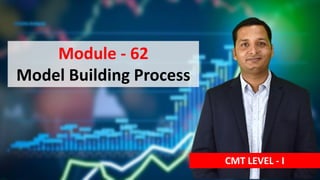
SECTION VII - CHAPTER 43 - Model Building Process
- 1. Module - 62 Model Building Process CMT LEVEL - I
- 2. The Model-Building Process • The Market–timing model can form the basis of an investor's market outlook by providing a benchmark for adjusting exposure to different types of assets. • By using objective, quantitative information and testing its predictive value against historical data, an investor can avoid making decisions based on emotion, gut feel, • A model with a variety of indicators, which individually have value in highlighting risk and reward, can offer a more stable, predictable, and reliable reflection of the market than any single indicator can.
- 3. The Model-Building Process “internal” and “external” indicators Sentiment and Valuation Indicators Monetary Indicators Economic Indicators Moving Averages Crossings and Slopes Momentum
- 4. Internal” and “external” indicators • Internal indicators are based on the market itself. They include price trend and momentum, as well as corollary indicators, • Our goal is to be in harmony with that trend. Internal measures typically account for half (or more) of the indicators in our timing models. • External indicators aren't derived from the market directly, but are known (or thought) to significantly influence it. The best example of an important external indicator is interest rates. Their level and direction have a major impact on the direction of stock prices.
- 5. Sentiment and Valuation Indicators • Sentiment Indicators are several regularly updated polls or surveys of various investors, including market newsletter writers, futures traders, and individuals. • These polls typically just ask the respondents whether they have a bullish (positive) or a bearish (negative) view on stocks and then aggregate the responses to give the percentage of the group that is bullish or bearish at any given time. • When a great majority of investors have the same view of the market, it is typically a warning to expect a reversal contrary to the majority opinion.
- 6. Sentiment and Valuation Indicators • The price investors are willing to pay for a stock, relative to its underlying assets or earnings, indicates their level of confidence or optimism about the prospects for that stock (or in the aggregate, the market). •When investors are very optimistic they will pay higher prices, as reflected in high price/earnings or price/book value ratios, while pessimistic investors will buy only at low valuation levels. • We see how much investors are paying for current valuations and compare that to historical norms.
- 7. Monetary Indicators • These reflect what is happening to the price of money (interest rates) and the supply (availability) of money. • Interest rates are a primary driver of stock returns, because high rates make debt securities relatively more attractive than equities to investors, and also drive up businesses' cost of raising capital. • Indicators based on the level and trend of interest rates (or bond prices, which are inversely related to rates) are common in our stock–market models.
- 8. Economic Indicators • broader category of external indicators can be classified simply as economic indicators. • These track economic vitality or inflation. • Examples are gross domestic product (GDP), the consumer price index (CPI), and surveys showing current and expected economic conditions • These indicators typically have the most effect on bond prices and interest rates, and thus on the actions of the Federal Reserve and on stock prices.
- 9. Moving Averages • One well–known way to get a handle on the underlying trend in stock prices is to use a moving average (MA). • When plotted on a chart, this continuously updated fixed– period average moves, along with the actual price data •It is smooth out the largely random short–term wiggles in the price of a stock or a market index, revealing the underlying trend. •the longer the time frame is, the more smoothing will occur and the less sensitive the results will be to the latest price changes.
- 10. Crossings and Slopes • The price can whip back and forth around the moving average and thus change its signal too frequently. • To get around that, a model can be built that recognizes signals, up or down, only if they're based on moves of a certain minimum size. • A change in trend is signaled when the short–term average (rather than the price itself) crosses above or below the longer term average. • This reduces the frequency of whipsaws, or short–term signals caused by random volatility in prices
- 11. Momentum • Momentum is typically measured as a rate of change, as in the distance an object travels in a given period, or the amount by which stock prices rise or fall in a given time span. • To calculate a 10–day momentum, simply divide the current price by the price 10 days ago and subtract 1 from the result. • A positive value indicates that the price trend is up, and a negative value implies a downtrend. •The high momentum reading implies that prices will continue on an upward path for some time, while a very low (negative) reading implies that a downtrend is under way.
- 12. Market–timing/asset” allocation model • Gather as much objective, quantitative data as possible. • Make certain that the information is accurate and can be updated in a relatively timely manner. •Test individual data series and the various manipulations of the data mentioned above against the market to determine if they have any potential predictive value. •Make sure not to over–fit the data to historical prices.
- 13. Market–timing/asset” allocation model •Select different types of indicators (e.g., trend, monetary, sentiment, etc.) based on their historical reliability and their ability to complement one another. •Combine the indicators into a model that gives a single composite reading. The indicators can be weighted equally or by their relative importance or historical accuracy. •Test the resulting model to see if it provides reliable results. •Use the model as the basis for disciplined investing.
